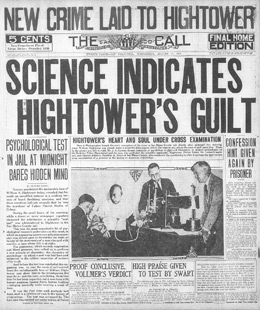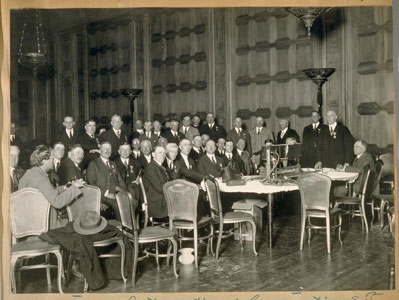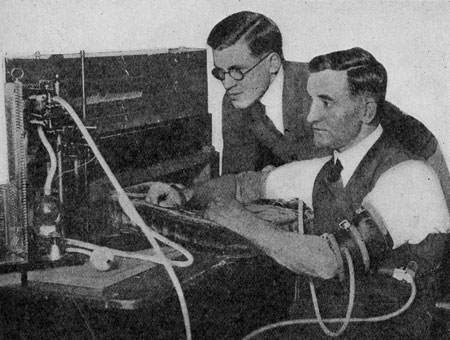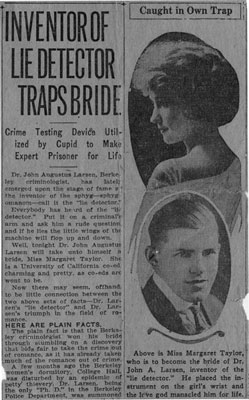JOHN LARSON’S CALIFORNIA
 |
This San Francisco Call and Post exclusive of August 17, 1921 conferred national fame on the “lie detector,” as the press now christened the device. A jury convicted the mysterious William Hightower of murdering a local priest soon after. |


Within a year Larson was demonstrating his machine to the annual assembly of the International Association of Chiefs of Police, whose president August Vollmer, had convened the 1922 meeting in San Francisco, in large part to show off his new methods of scientific police work. This photograph, taken in the Saint Francis hotel, has Larson largely obscured by his machine, with Vollmer standing to one side. [You may not recopy this image which is the property of the Bancroft Library; please contact them for rights].

 At the time, in 1922 Larson was investigating yet another scandalous San Francisco murder. The case time involved Henry Wilkens, accused of having arranged the murder of his own wife in a fake car-robbery, while their children watched from the back seat. Larson claimed that his test cleared Wilkens, although he admitted privately that Wilkens had shown signs of agitation, and Vollmer and Keeler both would disagree with his judgment. When the jury cleared Wilkens (who had also indirectly caused the death of a cop), the S.F. Police Department vowed to have nothing more to do with the device. At the time, in 1922 Larson was investigating yet another scandalous San Francisco murder. The case time involved Henry Wilkens, accused of having arranged the murder of his own wife in a fake car-robbery, while their children watched from the back seat. Larson claimed that his test cleared Wilkens, although he admitted privately that Wilkens had shown signs of agitation, and Vollmer and Keeler both would disagree with his judgment. When the jury cleared Wilkens (who had also indirectly caused the death of a cop), the S.F. Police Department vowed to have nothing more to do with the device.

| By then Larson had wed Margaret Taylor the freshman victim of the College Hall case and the first person he ever interrogated on the lie detector. Their meet-cute story became a staple of lie detector lore and was even incorporated into a Dick Tracy strip: how the machine not only can unmask the dark lies of criminality, but uncover the true nature of the human heart. Larson would soon come to doubt the effectiveness of his own creation, and he spent much of his career in a vain effort to deploy the instrument as a tool of psychiatric diagnosis. “Beyond my expectation,” he would write shortly before his death, “thru uncontrollable factors, this scientific investigation became for practical purposes a Frankenstein’s monster, which I have spent over 40 years in combatting.” |
 |
|